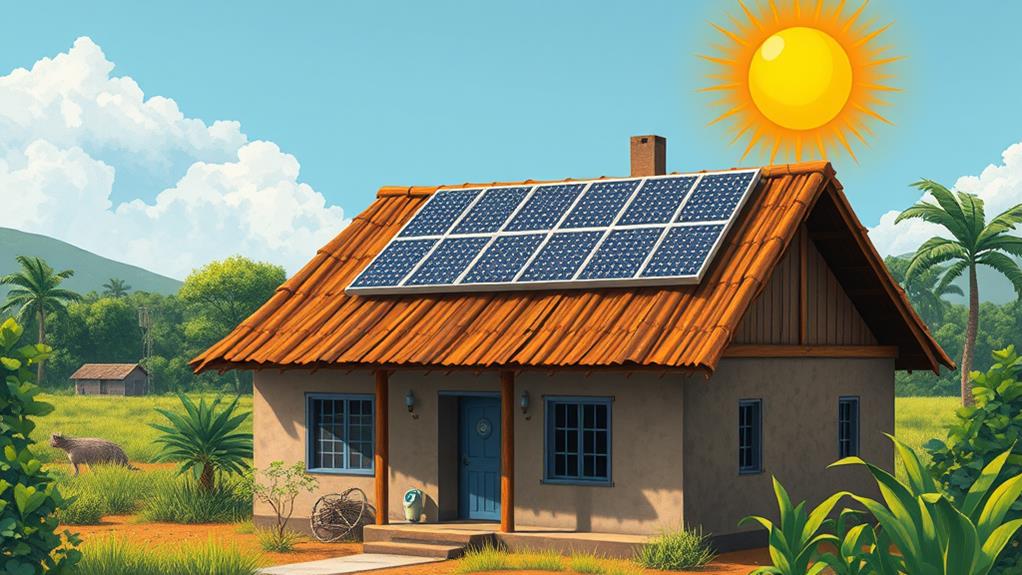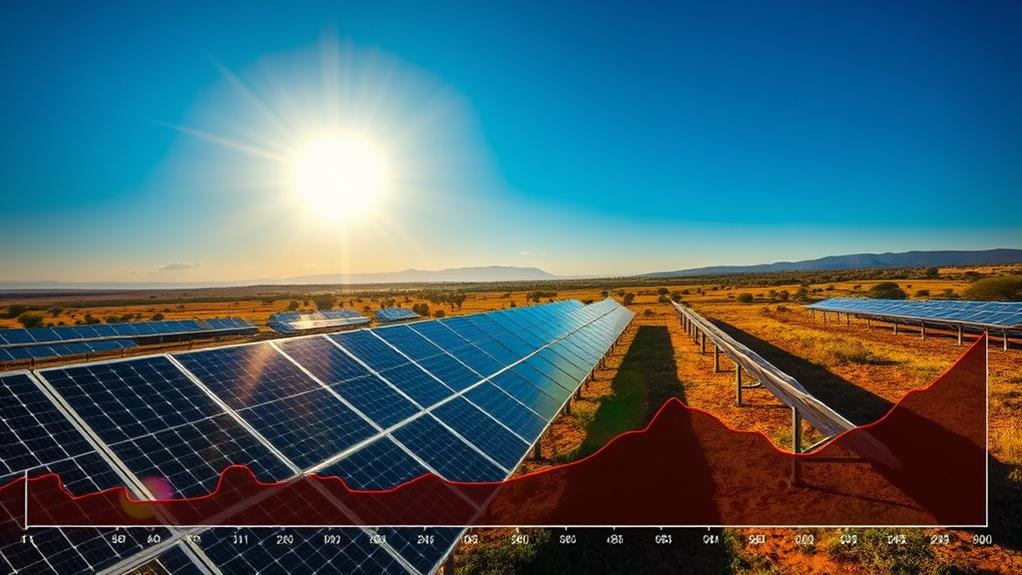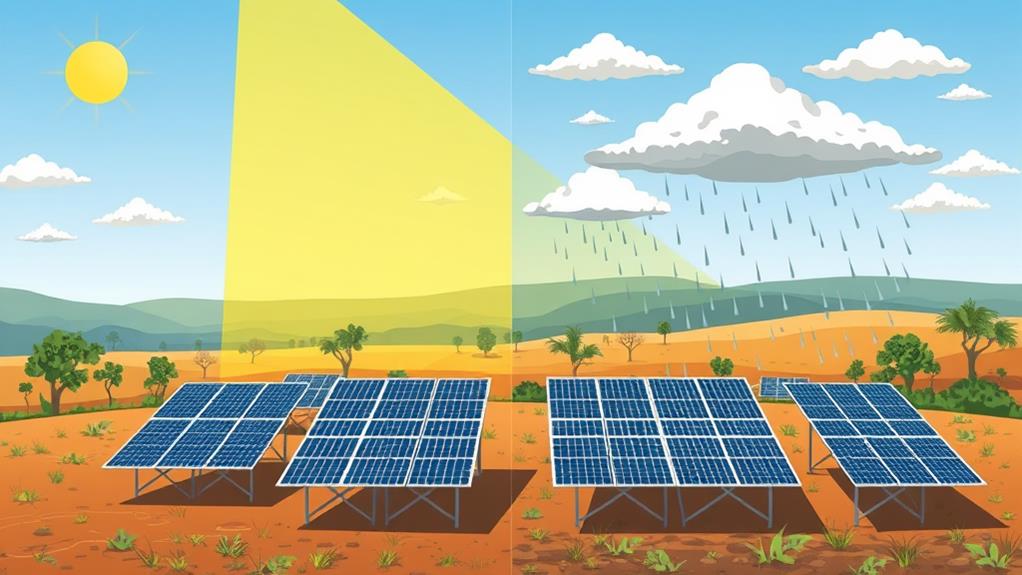If you're aiming to generate 2500 kWh per month using solar panels in Kenya, you'll need to take into account several factors, including your energy consumption patterns, the efficiency of the panels, and the amount of daily sunlight. Typically, in Kenya, you can expect around 5 peak sunlight hours per day, but this can fluctuate. Calculating the exact number of panels involves a bit more than simple math—local weather patterns and installation space also play significant roles. So, how do you guarantee you're making the most accurate assessment for your specific situation?
Understanding Your Energy Needs

When considering solar panels for a 2500 kWh per month requirement in Kenya, understanding your energy needs is vital.
You'll want to start by evaluating your current energy consumption patterns. Look at your recent electricity bills to determine your average monthly electricity usage. This gives you a clear picture of how much power your solar panel system needs to generate.
Additionally, keep in mind that solar irradiance varies due to location, time of day, and weather conditions, which can affect your energy production.
Next, identify the major appliances and devices contributing to your electricity usage. For instance, air conditioning units, refrigerators, and washing machines are typically high consumers of energy. Knowing which appliances use the most power helps you make informed decisions about potential energy reductions or optimizations.
Additionally, consider the number of people in your household and their daily routines. More occupants generally mean higher energy consumption.
Track when and how electricity is used throughout the day to pinpoint peak usage times. This data is significant for designing a solar panel system that meets your needs efficiently.
Solar Panel Efficiency
When considering solar panel efficiency for your 2500 Kwh monthly requirement in Kenya, you should evaluate the types of solar panels available, such as monocrystalline or polycrystalline.
Modern panels achieve efficiencies between 15% and 22%, which is vital for minimizing the number of panels needed.
Kenya's climate, with its high sunshine hours, greatly impacts efficiency, potentially boosting energy output.
Regular maintenance is essential to sustain performance and guarantee you meet your energy goals.
Types of Solar Panels
Understanding the different types of solar panels is essential for optimizing efficiency and meeting your energy needs in Kenya. The two main types you'll encounter are monocrystalline panels and polycrystalline panels.
Monocrystalline panels, made from single-crystal silicon, boast efficiency rates of 15-20%. Their uniform structure allows electrons to move more freely, leading to higher efficiency. Although they're more expensive upfront, their superior performance and longer lifespan make them a wise investment.
Polycrystalline panels, on the other hand, are composed of multiple silicon crystals melted together. These panels have efficiency rates between 13-16%. They're generally less expensive than monocrystalline panels, but their lower efficiency means you'll need more of them to achieve the same energy output.
Polycrystalline panels are a cost-effective choice if you have ample roof space and a tighter budget.
To meet your target of 2500 kWh per month, consider the efficiency and space available. If freedom and maximizing output matter to you, monocrystalline panels might be the better option despite their higher cost. Conversely, polycrystalline panels offer a more budget-friendly route while still delivering reliable performance.
Your choice will greatly impact how effectively you harness Kenya's abundant solar energy.
Climate Impact on Efficiency
Climate plays a pivotal role in determining the efficiency of solar panels, especially in a diverse environment like Kenya.
Temperature effects are essential; higher temperatures can reduce the efficiency of solar panels, so you'll want to take into account the cooler highlands if possible.
Humidity influence is another factor; high humidity levels can decrease the amount of sunlight reaching your panels, slightly lowering their output.
Altitude considerations are also important. Higher altitudes generally offer clearer skies and more intense sunlight, boosting efficiency.
Seasonal variations in Kenya mean you'll have to account for changes in sunlight throughout the year, with some months providing more solar energy than others.
Pollution impacts can't be ignored either. Dust and particulate matter in the air can settle on panels, reducing their effectiveness.
Shading factors must be meticulously managed; even a small shadow can considerably cut output.
Installation orientation is key—panels should ideally face the equator to maximize sunlight exposure.
Maintenance and Performance
Proper maintenance is vital for guaranteeing the ideal performance and efficiency of your solar panels in Kenya. Regular panel cleaning removes dust and debris, boosting efficiency by up to 20%.
Inverter maintenance is equally important, as inverters convert solar energy into usable power. Performance monitoring helps you detect inefficiencies early, allowing for timely interventions.
Kenya's varied weather conditions demand weather resilience. Verify your panels and mounting systems can withstand heavy rains and strong winds. Periodic installation inspections can identify potential issues, such as loose wiring or structural damage, preventing long-term inefficiencies.
System upgrades and energy storage solutions can further optimize your setup. Upgrading to more efficient panels or adding battery storage can greatly enhance energy output and reliability.
Proper panel orientation maximizes sunlight exposure, elevating your system's efficiency. Efficiency optimization also involves scrutinizing warranty considerations. A robust warranty can save you from unexpected costs and extend the lifespan of your system.
Calculating Daily Sunlight Hours

To calculate the daily sunlight hours, you'll need to know the average sunlight hours in Kenya, which typically ranges from 4 to 6 hours per day.
Advanced technologies enhance efficiency in energy conversion, which can help optimize your solar power system.
It's essential to account for regional sunlight variations, as areas like Nairobi and Mombasa may experience different sunlight patterns.
Accurate data on these variations will help you estimate the energy production potential of your solar panels.
For example, understanding the benefits of solar energy in reducing fossil fuel reliance can guide you in making informed decisions about solar investments.
Average Sunlight Hours
Kenya enjoys a significant amount of sunlight throughout the year, making it an ideal location for solar energy projects. To determine the average sunlight hours, you'll need to take into account several geographic factors that influence solar radiation.
On average, Kenya receives about 5-7 peak sunlight hours per day, which is essential for calculating how many solar panels you'll need.
To accurately calculate daily sunlight hours, follow these steps:
- Measure Solar Radiation: Identify the average solar radiation in your specific location in Kenya, typically measured in kWh/m²/day.
- Take into Account Geographic Factors: Take into account your location's latitude and altitude, as these affect the intensity and duration of sunlight.
- Utilize Solar Maps: Refer to solar maps or data from local meteorological stations to get precise sunlight hours.
- Adjust for Seasonal Variations: While Kenya has a fairly consistent climate, slight variations in sunlight hours can occur throughout the year.
Regional Sunlight Variations
Although Kenya generally enjoys ample sunlight, regional sunlight variations can considerably impact your solar energy calculations. Different areas experience varying levels of solar radiation due to geographic influences such as altitude, cloud cover, and proximity to the equator.
For instance, regions like Nairobi and Mombasa receive different amounts of solar radiation. Nairobi, situated at a higher altitude, may experience cooler temperatures and occasional cloudy days, impacting the efficiency of your solar panels.
To accurately calculate your daily sunlight hours, you need to take into account the solar radiation variability specific to your location. Solar radiation maps or data from meteorological stations can help you determine the average daily sunlight hours for your area.
In Kenya, the average ranges between 4 to 6 peak sunlight hours per day, but this can fluctuate.
For more precise data, you can use online solar calculators that incorporate geographic influences and provide tailored results based on your exact location. This will guarantee that your solar panel system is optimized for the specific conditions in your area, maximizing energy production and contributing to your goal of generating 2500 Kwh per month.
Freedom to harness the sun's power starts with understanding these regional variations.
Estimating Panel Output
Determining the output of solar panels is essential for ensuring they meet your energy needs.
To calculate how many panels you need to generate 2500 kWh per month in Kenya, you've got to take into account panel performance and how you'll handle energy storage.
Solar energy has the transformative potential to greatly reduce electricity costs and promote sustainability.
Here's a step-by-step breakdown:
- Calculate Daily Energy Needs: Divide your monthly requirement (2500 kWh) by 30 days. You'll need around 83.33 kWh per day.
- Estimate Sunlight Hours: Kenya typically receives about 5 peak sunlight hours per day.
- Determine Panel Output: Most solar panels produce around 300 watts per hour. Multiply 300 watts by 5 sunlight hours to get 1.5 kWh per panel per day.
- Number of Panels: Divide your daily energy need (83.33 kWh) by the daily output per panel (1.5 kWh). You'll need approximately 56 panels.
Local Weather Impact

While estimating the number of solar panels needed is straightforward, you must also consider how local weather conditions could impact your system's performance. Kenya's weather patterns, including seasonal fluctuations, directly influence solar radiation levels. During the rainy seasons, cloud cover reduces the amount of sunlight your panels receive, thereby decreasing their efficiency. Implementing off-grid solutions tailored to local conditions can help mitigate these challenges.
Understanding the local climate is essential. In areas with high humidity levels, moisture can affect the panels' effectiveness and longevity. You should also account for temperature effects; although solar panels function better in cooler conditions, Kenya's warm climate can cause them to operate less efficiently.
Weather forecasting can help you plan for these variations. By analyzing historical weather data, you can predict how much solar energy your panels will generate throughout the year. This allows you to adjust your system as needed to guarantee consistent energy production.
Final Panel Count
To finalize the number of solar panels you'll need, start by calculating your energy requirement in kilowatt-hours per day. For 2500 kWh per month, you'll need approximately 83.33 kWh per day.
Next, consider the following steps to determine the final panel count:
- Daily Sunlight Hours: In Kenya, you typically get about 5.5 peak sunlight hours per day.
- Panel Output: A standard solar panel generates around 300 watts or 0.3 kW.
- Daily Panel Production: Multiply the panel output by daily sunlight hours (0.3 kW * 5.5 hours = 1.65 kWh per panel per day).
- Total Panels Needed: Divide your daily energy requirement by the daily panel production (83.33 kWh / 1.65 kWh per panel = ~51 panels).
For panel placement, verify your roof or ground space can accommodate around 51 panels, considering ideal angles and spacing to maximize efficiency.
Installation costs will vary based on labor, equipment, and any additional infrastructure needed, such as inverters and batteries.
Conclusion
To power your home with 2500 kWh per month in Kenya, you'll need around 51 solar panels. Picture your roof gleaming with an array of efficient panels, each harnessing the sun's power for about 5 peak hours daily. Factor in local weather and maintenance for peak performance. With careful planning, your solar setup will be a shining beacon of sustainable energy, reliably meeting your needs and reducing your carbon footprint.
